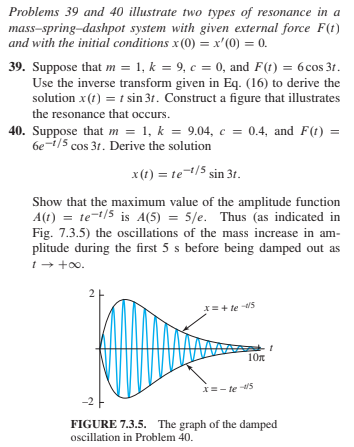Problems 39 and 40 illustrate two types of resonance in a mass-spring-dashpot system with given external force F(t) and with the initial conditions x (0) = x'(0) = 0. 39. Suppose that m = 1, k = 9, c = 0, and F(t) = 6cos 31. Use the inverse transform given in Eq. (16) to derive the solution x(1) = t sin 3t. Construct a figure that illustrates the resonance that occurs. 40. Suppose that m = 1, k = 9.04, c = 0.4, and F(t) = 6e-i/5 cos 3t. Derive the solution x(1) = te/5 sin 3t. Show that the maximum value of the amplitude function A(t) = te-t/5 is A(5) = 5/e. Thus (as indicated in Fig. 7.3.5) the oscillations of the mass increase in am- plitude during the first 5 s before being damped out as t + +0o. X= + te -s 10n *=- te -5 FIGURE 7.3.5. The graph of the damped oscillation in Problem 40.
Problems 39 and 40 illustrate two types of resonance in a mass-spring-dashpot system with given external force F(t) and with the initial conditions x (0) = x'(0) = 0. 39. Suppose that m = 1, k = 9, c = 0, and F(t) = 6cos 31. Use the inverse transform given in Eq. (16) to derive the solution x(1) = t sin 3t. Construct a figure that illustrates the resonance that occurs. 40. Suppose that m = 1, k = 9.04, c = 0.4, and F(t) = 6e-i/5 cos 3t. Derive the solution x(1) = te/5 sin 3t. Show that the maximum value of the amplitude function A(t) = te-t/5 is A(5) = 5/e. Thus (as indicated in Fig. 7.3.5) the oscillations of the mass increase in am- plitude during the first 5 s before being damped out as t + +0o. X= + te -s 10n *=- te -5 FIGURE 7.3.5. The graph of the damped oscillation in Problem 40.
Calculus: Early Transcendentals
8th Edition
ISBN:9781285741550
Author:James Stewart
Publisher:James Stewart
Chapter1: Functions And Models
Section: Chapter Questions
Problem 1RCC: (a) What is a function? What are its domain and range? (b) What is the graph of a function? (c) How...
Related questions
Question

Transcribed Image Text:Problems 39 and 40 illustrate two types of resonance in a
mass-spring-dashpot system with given external force F(t)
and with the initial conditions x (0) = x'(0) = 0.
39. Suppose that m = 1, k = 9, c = 0, and F(t) = 6cos 31.
Use the inverse transform given in Eq. (16) to derive the
solution x(1) = t sin 3t. Construct a figure that illustrates
the resonance that occurs.
40. Suppose that m = 1, k = 9.04, c = 0.4, and F(t) =
6e-i/5 cos 3t. Derive the solution
x(1) = te/5 sin 3t.
Show that the maximum value of the amplitude function
A(t) = te-t/5 is A(5) = 5/e. Thus (as indicated in
Fig. 7.3.5) the oscillations of the mass increase in am-
plitude during the first 5 s before being damped out as
t + +0o.
X= + te -s
10n
*=- te -5
FIGURE 7.3.5. The graph of the damped
oscillation in Problem 40.
Expert Solution
This question has been solved!
Explore an expertly crafted, step-by-step solution for a thorough understanding of key concepts.
This is a popular solution!
Trending now
This is a popular solution!
Step by step
Solved in 5 steps with 5 images

Recommended textbooks for you

Calculus: Early Transcendentals
Calculus
ISBN:
9781285741550
Author:
James Stewart
Publisher:
Cengage Learning

Thomas' Calculus (14th Edition)
Calculus
ISBN:
9780134438986
Author:
Joel R. Hass, Christopher E. Heil, Maurice D. Weir
Publisher:
PEARSON

Calculus: Early Transcendentals (3rd Edition)
Calculus
ISBN:
9780134763644
Author:
William L. Briggs, Lyle Cochran, Bernard Gillett, Eric Schulz
Publisher:
PEARSON

Calculus: Early Transcendentals
Calculus
ISBN:
9781285741550
Author:
James Stewart
Publisher:
Cengage Learning

Thomas' Calculus (14th Edition)
Calculus
ISBN:
9780134438986
Author:
Joel R. Hass, Christopher E. Heil, Maurice D. Weir
Publisher:
PEARSON

Calculus: Early Transcendentals (3rd Edition)
Calculus
ISBN:
9780134763644
Author:
William L. Briggs, Lyle Cochran, Bernard Gillett, Eric Schulz
Publisher:
PEARSON

Calculus: Early Transcendentals
Calculus
ISBN:
9781319050740
Author:
Jon Rogawski, Colin Adams, Robert Franzosa
Publisher:
W. H. Freeman


Calculus: Early Transcendental Functions
Calculus
ISBN:
9781337552516
Author:
Ron Larson, Bruce H. Edwards
Publisher:
Cengage Learning